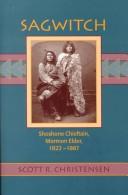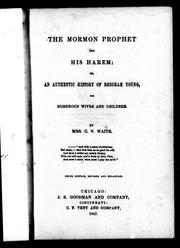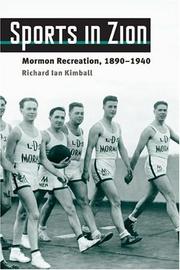| Listing 1 - 10 of 49 | << page >> |
Sort by
|
Periodical
ISSN: 02777363 Year: 1959 Publisher: [Provo, Utah] : [Brigham Young University],
Abstract | Keywords | Export | Availability | Bookmark
 Loading...
Loading...Choose an application
- Reference Manager
- EndNote
- RefWorks (Direct export to RefWorks)
Mormons --- Mormons. --- Mormoni --- Latter-Day Saints --- Christians --- Latter Day Saints --- Brighamite Mormons --- Church of Christ (Temple Lot) members --- Church of Jesus Christ of Latter-day Saints members --- Church of Jesus Christ (Strangites) members --- Hedrikites --- Josephite Mormons --- Reorganized Church of Jesus Christ of Latter Day Saints members --- Reorganized Mormons --- RLDS Mormons --- Strangite Mormons --- Temple Lot Mormons --- Utah Mormons --- Latter Day Saints.
Book
ISBN: 1469628643 1469628651 9781469628653 9781469628646 1469628635 1469630222 9781469630229 9781469628639 9798890848543 Year: 2016 Publisher: Chapel Hill
Abstract | Keywords | Export | Availability | Bookmark
 Loading...
Loading...Choose an application
- Reference Manager
- EndNote
- RefWorks (Direct export to RefWorks)
"The book situates American universities as a unique egalitarian cultural and institutional space for Mormons in nineteenth-century American society. They were places where Mormons could experience a personally transformative sense of freedom and dignity, equip themselves for taking advantageous paths in American society, and explore provisional reconciliations of religious and scientific perspectives. Contributing to an understanding of the evolution of the Church of the Latter-Day Saints in the context of American history, Simpson chronicles a Mormon intellectual pilgrimage made by hundreds of youth to the elite universities of the United States"--
Mormons --- Education, Higher --- Latter-Day Saints --- Christians --- Intellectual life. --- History. --- Education (Higher) --- Latter Day Saints --- Brighamite Mormons --- Church of Christ (Temple Lot) members --- Church of Jesus Christ of Latter-day Saints members --- Church of Jesus Christ (Strangites) members --- Hedrikites --- Josephite Mormons --- Reorganized Church of Jesus Christ of Latter Day Saints members --- Reorganized Mormons --- RLDS Mormons --- Strangite Mormons --- Temple Lot Mormons --- Utah Mormons

ISBN: 0874212707 0874213592 0585207623 Year: 1999 Publisher: Logan, Utah : Utah State University, University Libraries,
Abstract | Keywords | Export | Availability | Bookmark
 Loading...
Loading...Choose an application
- Reference Manager
- EndNote
- RefWorks (Direct export to RefWorks)
The Northwestern Shoshone knew as home the northern Great Salt Lake, Bear River, Cache, and Bear Lake valleys-northern Utah. Sagwitch was born at a time when his people traded with the mountain men. In the late 1850s, wagons brought Mormon farmers to settle in Cache Valley, the Northwestern Shoshone heartland. Emigrants and settlers reduced Shoshone access to traditional village sites and food resources. Relationships with the Mormons were mostly good but often strained, and the Shoshone treatment of migrants, who now traveled north and south as well as west and east through the area, was increasingly opportunistic. It only took a few violent incidents for a zealous army colonel to seek severe punishment of the Northwestern Shoshone on a winter morning in 1863. The Bear River Massacre was among the bloodiest engagements of America's Indian wars. Hundreds of Shoshone, including Sagwitch's wife and two sons, died; he was wounded but escaped. The band was shattered; other chiefs dead.The following years were very hard for the survivors. The federal government negotiated a treaty with them but failed to get Sagwitch's signature when, enroute to the sessions, he was arrested and then wounded by a white assassin. With the world around him changed, Sagwitch sought accommodation with the most immediate threat to his people's traditional way of survival-the Mormons occupying the Shoshone's valleys.This, then, is also the story of the conversion of Sagwitch and his band to the Mormon Church. Though not without problems, that conversion was long lasting and thorough. Sagwitch and other Shoshone would demonstrate in important ways their new religious devotion. With the assistance of Mormon leaders, they established the Washakie community in northern Utah. Though efforts to secure a land base had an uneven history, they partly succeeded, and the story of these Shoshone's attempts at rural farming diverged significantly from what happened on government reservations. When Sagwitch died, his death went almost unnoticed outside of Washakie, but his children and grandchildren continued to be important voices among a people who, after experiencing near annihilation, survived in the new world into which Sagwitch led them.
Shoshoni Indians --- Mormons --- History --- Sagwitch, --- Shoshone Indians --- Snake Indians --- Indians of North America --- Numic Indians --- Shoshonean Indians --- Latter Day Saints --- Brighamite Mormons --- Church of Christ (Temple Lot) members --- Church of Jesus Christ of Latter-day Saints members --- Church of Jesus Christ (Strangites) members --- Hedrikites --- Josephite Mormons --- Reorganized Church of Jesus Christ of Latter Day Saints members --- Reorganized Mormons --- RLDS Mormons --- Strangite Mormons --- Temple Lot Mormons --- Utah Mormons --- Christians
Book
ISBN: 0874217229 9786612822230 0874217237 1282822233 9780874217230 9780874217223 9781282822238 Year: 2008 Publisher: Logan, Utah Utah State University Press
Abstract | Keywords | Export | Availability | Bookmark
 Loading...
Loading...Choose an application
- Reference Manager
- EndNote
- RefWorks (Direct export to RefWorks)
Winner of the Evans Handcart Prize 2009. Winner of the Mormon History Assn Best Biography Award 2009. By the early twentieth century, the era of organized Mormon colonization of the West from a base in Salt Lake City was all but over. One significant region of Utah had not been colonized because it remained in Native American hands--the Uinta Basin, site of a reservation for the Northern Utes. When the federal government decided to open the reservation to white settlement, William H. Smart--a nineteenth-century Mormon traditionalist living in the twentieth century, a polygamist in an era when it was banned, a fervently moral stake president who as a youth had struggled mightily with his own sense of sinfulness, and an entrepreneurial businessman with theocratic, communal instincts--set out to ensure that the Uinta Basin also would be part of the Mormon kingdom. Included with the biography is a searchable CD containing William H. Smart's extensive journals, a monumental personal record of Mormondom and its transitional period from nineteenth-century cultural isolation into twentieth-century national integration.
Mormons -- Utah -- Biography. --- Smart, William H. (William Henry), 1862-1937. --- Utah -- History. --- Mormons --- Religion --- Philosophy & Religion --- Christianity --- Smart, William H. --- Utah --- History. --- Latter Day Saints --- Brighamite Mormons --- Church of Christ (Temple Lot) members --- Church of Jesus Christ of Latter-day Saints members --- Church of Jesus Christ (Strangites) members --- Hedrikites --- Josephite Mormons --- Reorganized Church of Jesus Christ of Latter Day Saints members --- Reorganized Mormons --- RLDS Mormons --- Strangite Mormons --- Temple Lot Mormons --- Utah Mormons --- Christians
Periodical
ISSN: 15549399 00122157
Abstract | Keywords | Export | Availability | Bookmark
 Loading...
Loading...Choose an application
- Reference Manager
- EndNote
- RefWorks (Direct export to RefWorks)
"A journal of Mormon thought."
Mormon Church --- Mormons --- Mormon Church. --- Mormons. --- Latter-Day Saints --- Mormonism --- Christian sects --- Arts and Humanities --- Religion --- Christians --- Latter Day Saints --- Latter Day Saint churches --- Brighamite Mormons --- Church of Christ (Temple Lot) members --- Church of Jesus Christ of Latter-day Saints members --- Church of Jesus Christ (Strangites) members --- Hedrikites --- Josephite Mormons --- Reorganized Church of Jesus Christ of Latter Day Saints members --- Reorganized Mormons --- RLDS Mormons --- Strangite Mormons --- Temple Lot Mormons --- Utah Mormons
Periodical
ISSN: 21568022
Abstract | Keywords | Export | Availability | Bookmark
 Loading...
Loading...Choose an application
- Reference Manager
- EndNote
- RefWorks (Direct export to RefWorks)
Mormons --- Mormon Church --- Mormonism --- Latter-Day Saints --- Mormon Church. --- Mormons. --- Christian sects --- Christians --- Latter Day Saints --- Église mormone --- Brighamite Mormons --- Church of Christ (Temple Lot) members --- Church of Jesus Christ of Latter-day Saints members --- Church of Jesus Christ (Strangites) members --- Hedrikites --- Josephite Mormons --- Reorganized Church of Jesus Christ of Latter Day Saints members --- Reorganized Mormons --- RLDS Mormons --- Strangite Mormons --- Temple Lot Mormons --- Utah Mormons --- Latter Day Saint churches

ISBN: 066537321X Year: 1867 Publisher: Chicago : Cincinnati : J.S. Goodman; C.F. Vent,
Abstract | Keywords | Export | Availability | Bookmark
 Loading...
Loading...Choose an application
- Reference Manager
- EndNote
- RefWorks (Direct export to RefWorks)
Mormon Church --- Mormons --- History. --- Histoire. --- Young, Brigham, --- Église mormone --- Mormonism --- Christian sects --- Brighamite Mormons --- Church of Christ (Temple Lot) members --- Church of Jesus Christ of Latter-day Saints members --- Church of Jesus Christ (Strangites) members --- Hedrikites --- Josephite Mormons --- Reorganized Church of Jesus Christ of Latter Day Saints members --- Reorganized Mormons --- RLDS Mormons --- Strangite Mormons --- Temple Lot Mormons --- Utah Mormons --- Christians --- Latter Day Saint churches --- Latter Day Saints

ISBN: 1283583593 9786613896049 0252091612 9780252091612 0252028570 9780252028571 0252076362 9780252076367 Year: 2003 Publisher: Urbana
Abstract | Keywords | Export | Availability | Bookmark
 Loading...
Loading...Choose an application
- Reference Manager
- EndNote
- RefWorks (Direct export to RefWorks)
Mormons --- Recreation --- Latter-Day Saints --- Christians --- Manners and customs --- Amusements --- Community centers --- Leisure --- Social life and customs. --- History. --- Latter Day Saints --- Brighamite Mormons --- Church of Christ (Temple Lot) members --- Church of Jesus Christ of Latter-day Saints members --- Church of Jesus Christ (Strangites) members --- Hedrikites --- Josephite Mormons --- Reorganized Church of Jesus Christ of Latter Day Saints members --- Reorganized Mormons --- RLDS Mormons --- Strangite Mormons --- Temple Lot Mormons --- Utah Mormons
Book
ISBN: 1607812851 9781607812852 9781607812845 1607812843 Year: 2013 Publisher: Salt Lake City
Abstract | Keywords | Export | Availability | Bookmark
 Loading...
Loading...Choose an application
- Reference Manager
- EndNote
- RefWorks (Direct export to RefWorks)
Mormons --- Latter-Day Saints --- Christians --- Folklore. --- Mormon Church --- Mormonism --- Christian sects --- Latter Day Saints --- Brighamite Mormons --- Church of Christ (Temple Lot) members --- Church of Jesus Christ of Latter-day Saints members --- Church of Jesus Christ (Strangites) members --- Hedrikites --- Josephite Mormons --- Reorganized Church of Jesus Christ of Latter Day Saints members --- Reorganized Mormons --- RLDS Mormons --- Strangite Mormons --- Temple Lot Mormons --- Utah Mormons --- Latter Day Saint churches
Book
ISBN: 0803274068 080327405X 9780803274051 9780803271845 0803271840 9780803274068 9780803274075 Year: 2015 Publisher: Lincoln, Nebraska ; London, England : University of Nebraska Press,
Abstract | Keywords | Export | Availability | Bookmark
 Loading...
Loading...Choose an application
- Reference Manager
- EndNote
- RefWorks (Direct export to RefWorks)
"Nineteenth-century novel that advocates the abolition of plural marriage in the Mormon religion and the repatriation of former practitioners by tracing the marital misfortunes of a Mormon convert"-- "The practice of plural marriage, commonly known as polygamy, stirred intense controversy in postbellum America until 1890, when the Church of Jesus Christ of Latter-day Saints first officially abolished the practice. Elder Northfield's Home, published by A. Jennie Bartlett in 1882, is both a staunchly antipolygamy novel and a call for the sentimental repatriation of polygamy's victims. Her book traces the fate of a virtuous and educated English immigrant woman, Marion Wescott, who marries a Mormon elder, Henry Northfield. Shocked when her husband violates his promise not to take a second wife, Marion attempts to flee during the night, toddler son in her arms, pulling her worldly possessions in his toy wagon. She returns to her husband, however, and the balance of the novel traces the effects of polygamy on Marion, Henry, and their children; their eventual rejection of plural marriage; and their return to a normal and healthy family structure. Nicole Tonkovich's critical introduction includes both historical contextualization and comments on selected primary documents, providing a broader look at the general public's reception of the practice of polygamy in the nineteenth century. "--
RELIGION / Christianity / Church of Jesus Christ of Latter-day Saints (Mormon). --- SOCIAL SCIENCE / Women's Studies. --- FICTION / Literary. --- Polygamy --- Marriage --- Mormons --- Utah --- Brighamite Mormons --- Church of Christ (Temple Lot) members --- Church of Jesus Christ of Latter-day Saints members --- Church of Jesus Christ (Strangites) members --- Hedrikites --- Josephite Mormons --- Reorganized Church of Jesus Christ of Latter Day Saints members --- Reorganized Mormons --- RLDS Mormons --- Strangite Mormons --- Temple Lot Mormons --- Utah Mormons --- Christians --- Latter Day Saints
| Listing 1 - 10 of 49 | << page >> |
Sort by
|

 Search
Search Feedback
Feedback About UniCat
About UniCat  Help
Help News
News